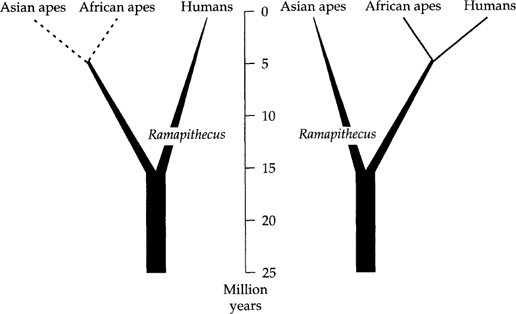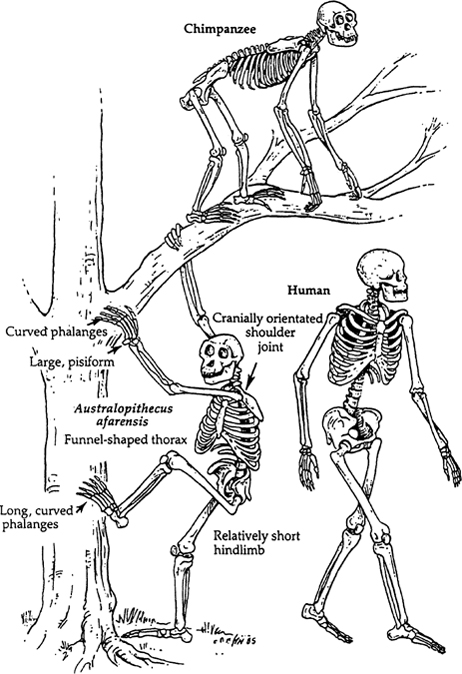The Origin of Humankind (3 page)
Read The Origin of Humankind Online
Authors: Richard Leakey

Although in their original publication Wilson and Sarich had proposed a date of 5 million years ago for this event, the consensus of molecular evidence these days pushes it back to close to 7 million years ago. There has, however, been no retreat from the proposed biological intimacy between humans and African apes. If anything, that relationship may be even more intimate than had been supposed. Although some geneticists believe that the molecular data still implies an equal three-way split between humans, chimpanzees, and gorillas, others see it differently. In their view, humans and chimpanzees are each other’s closest relatives, with gorillas at the greater evolutionary distance.

Molecular evidence. Before 1967, anthropologists interpreted fossil evidence as indicating an ancient evolutionary divergence between humans and apes: at least 15 million years ago. But in that year, molecular evidence was presented that showed the divergence to be much more recent: close to 5 million years ago. Anthropologists were reluctant to accept the new evidence but eventually did so.
The
Ramapithecus
affair changed anthropology in two ways. First, it demonstrated the perils of inferring a shared evolutionary relationship from shared anatomical features. Second, it exposed the folly of a slavish adherence to the Darwinian “package.” Simons and Pilbeam had imputed a complete lifestyle to
Ramapithecus
, based on the shape of the canine teeth: if one hominid feature was there,
all
such features were assumed to be present. As a result of the undermining of the hominid status of
Ramapithecus
, anthropologists began to be uncertain about the Darwinian package.
Before we follow the course of this anthropological revolution, we should look briefly at some of the hypotheses that over the years have been proposed to explain how the first hominid species might have arisen. It is interesting that as each new hypothesis gained popularity, it often reflected something of the social climate of the time. For instance, Darwin saw the elaboration of stone weapons as important in initiating the evolutionary package of technology, bipedalism, and expanded brain size. The hypothesis surely reflected the prevailing notion that life was a battle and progress was won by initiative and effort. This Victorian ethos permeated science, and shaped the way the process of evolution, including human evolution, was viewed.
In the early decades of this century, the heyday of Edwardian optimism, the brain and its higher thoughts were said to have made us what we are. Within anthropology, this prevailing social worldview was expressed in the notion that human evolution had been propelled initially not by bipedalism but by an expanding brain. By the 1940s, the world was in thrall to the magic and power of technology, and the “Man the Toolmaker” hypothesis became popular. Proposed by Kenneth Oakley of the Natural History Museum, London, this hypothesis held that the making and using of stone tools—not weapons—provided the impulse for our evolution. And when the world was in the shadow of the Second World War, a darker differentiation of humans from apes was emphasized—that of violence against one’s fellows. The notion of “Man the Killer Ape,” first proposed by the Australian anatomist Raymond Dart, gained wide adherence, possibly because it seemed to explain (or even excuse) the horrible events of the war.
Later, in the 1960s, anthropologists turned to the hunter-gatherer way of life as the key to human origins. Several research teams had been studying modern populations of technologically primitive people, particularly in Africa, most notable among whom were the !Kung San (incorrectly called Bushmen). There emerged an image of people in tune with nature, exploiting it in complex ways while respecting it. This vision of humanity coincided well with the environmentalism of the time, but anthropologists were in any case impressed by the complexity and economic security of the mixed economy of hunting and gathering. Hunting, however, was what was emphasized. In 1966, a major anthropological conference entitled “Man the Hunter” was held at the University of Chicago. The overriding tenor of the gathering was simple: hunting made humans human.
Hunting is generally a male responsibility in most technologically primitive societies. It is therefore not surprising that the growing awareness of women’s issues in the 1970s threw into question this male-centered explanation of human origins. An alternative hypothesis, known as “Woman the Gatherer,” held that as in all primate species, the core of society is the bond between female and offspring. And it was the initiative of human females in inventing technology and gathering food (principally plants) which could be shared by all that led to the formation of a complex human society. Or so it was argued.
Although these hypotheses differed in what was claimed as the principal mover in human evolution, all have in common the notion that the Darwinian package of certain valued human characteristics was established right from the beginning: the first hominid species was still thought to possess some degree of bipedalism, technology, and increased brain size. Hominids were therefore cultural creatures—and thus distinct from the rest of nature—right from the start. In recent years, we have come to recognize that this is not the case.
In fact, concrete evidence of the inadequacy of the Darwinian hypothesis is to be found in the archeological record. If the Darwinian package were correct, then we would expect to see the simultaneous appearance in the archeological and fossil records of evidence for bipedality, technology, and increased brain size. We don’t. Just one aspect of the prehistoric record is sufficient to show that the hypothesis is wrong: the record of stone tools.
Unlike bones, which only rarely become fossilized, stone tools are virtually indestructible. Much of the prehistoric record is therefore made up of them, and they are the evidence on which the progress of technology from its simplest beginnings is constructed.
The earliest examples of such tools—crude flakes, scrapers, and choppers made from pebbles with a few flakes removed—appear in the record about 2.5 million years ago. If the molecular evidence is correct and the first human species appeared some 7 million years ago, then almost 5 million years passed between the time our ancestors became bipedal and the time when they started making stone tools. Whatever the evolutionary force that produced a bipedal ape, it was not linked with the ability to make and use tools. However, many anthropologists believe that the advent of technology 2.5 million years ago did coincide with the beginnings of brain expansion.
The realization that brain expansion and technology are divorced in time from human origins forced anthropologists to rethink their approach. As a result, the latest hypotheses have been framed in biological rather than cultural terms. I consider this a healthy development in the profession—not least because it allows ideas to be tested by comparing them with what we know of the ecology and behavior of other animals. In so doing, we don’t have to deny that
Homo sapiens
has many special attributes. Instead, we look for the emergence of those attributes from a strictly biological context.
With this realization in place, the task of the anthropologist in accounting for human origins refocused on the origin of bipedalism. Even stripped down to this single event, the evolutionary transformation was not trivial, as Owen Lovejoy, an anatomist at Kent State University, has noted. “The move to bipedalism is one of the most striking shifts in anatomy you can see in evolutionary biology,” he wrote in a popular article in 1988. “There are important changes in the bones, the arrangement of the muscles that power them, and the movement of the limbs.” A glance at the pelvises of humans and chimpanzees is sufficient to confirm this observation: In humans, the pelvis is squat and boxlike, while in chimps it is elongated; and there are major differences in the limbs and trunk, too (see
figure 1.2
).
The advent of bipedalism is not just a major biological transformation but a major adaptive one as well. As I argued in the preface, the origin of bipedal locomotion is so significant an adaptation that we are justified in calling all species of bipedal ape “human.” This is not to say that the first bipedal ape species possessed a degree of technology, increased intellect, or any of the cultural attributes of humanity. It didn’t. My point is that the adoption of bipedalism was so loaded with evolutionary potential—allowing the upper limbs to be free to become manipulative implements one day—that its importance should be recognized in our nomenclature. These humans were not like us, but without the bipedal adaptation they couldn’t have become like us.
What were the evolutionary factors that promoted the adoption of this novel form of locomotion in an African ape? The popular image of human origins often includes the notion of an apelike creature leaving the forests and striding onto the open savanna. A dramatic image no doubt, but entirely inaccurate, as has recently been demonstrated by researchers at Harvard and Yale Universities who have analyzed soil chemistry in many parts of East Africa. The African savannas, with their great migrating herds, are relatively recent in the environment, developing less than 3 million years ago, long after the first human species evolved.

Different modes of locomotion. The shift from quadrupedal to bipedal locomotion demanded substantial changes in the body’s anatomical structure. For instance, humans have longer hind limbs, shorter fore-limbs, a squatter pelvis, shorter and noncurved digits, and a reduced lumbar region, compared with chimpanzees and gorillas.
Australopithecus afarensiSy
the earliest-known hominid, undoubtedly was a biped, but retained some anatomical features of tree dwellers. (Courtesy of John Fleagle/Academic Press.)
If we take our minds back to an Africa of 15 million years ago, we find a carpet of forest from west to east, home to a great diversity of primates, including many species of monkeys and apes. In contrast with the situation today, ape species greatly outnumbered monkey species. Geological forces were stirring, however, which would dramatically alter the terrain and its occupants during the next few million years.
The earth’s crust was tearing itself apart beneath the eastern part of the continent, in a line from the Red Sea through present-day Ethiopia, Kenya, Tanzania, and into Mozambique. As a result, the land rose blisterlike in Ethiopia and Kenya, forming great highlands more than 9000 feet in altitude. These great domes transformed not only the continent’s topography but its climate. Disrupting the previously uniform west-to-east airflow, the domes threw the lands to the east into rain shadow, depriving the forests of their sustenance. The continuous tree cover began to fragment, leaving a mosaic environment of forest patches, woodland, and shrubland. Open grassland, however, was still rare.
About 12 million years ago, a continuation of tectonic forces further changed the environment, with the formation of a long, sinuous valley, running from north to south, known as the Great Rift Valley. The existence of the Great Rift Valley has had two biological effects: it poses a formidable east-west barrier to animal populations; and it further promotes the development of a rich mosaic of ecological conditions.
The French anthropologist Yves Coppens believes the east-west barrier was crucial to the separate evolution of humans and apes. “By force of circumstance, the population of the common ancestor of [humans] and [apes] . . . found itself divided,” he wrote recently. “The western descendants of these common ancestors pursued their adaptation to life in a humid, arboreal milieu; these are the [apes]. The eastern descendants of these same common ancestors, in contrast, invented a completely new repertoire in order to adapt to their new life in an open environment: these are the [humans].” Coppens dubs this scenario the “East side story.”
